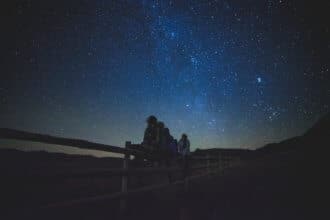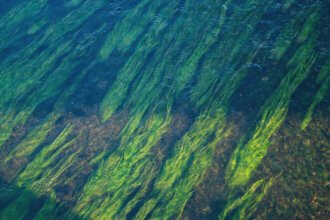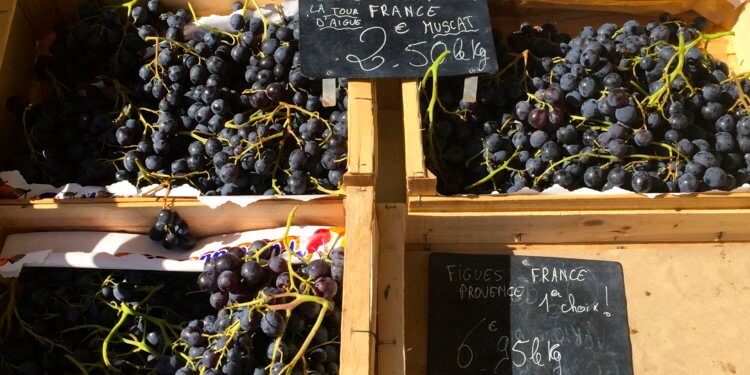
By Marcia De Sanctis
One of the great pleasures of writing a book about France is having the opportunity to give talks about some of my most beloved places. My audience is often a sea of erudite women assembled over petits-fours or roast lamb lunches. At the conclusion, the question always comes, inevitable as the sunrise: “But what is your very most, number one place in France?” My answer is always the same–the truth, but a non-committal one. “Any table in the sun with a glass of rosé,” I say to knowing nods. But recently, on a solo road trip along the Riviera, old memories and fresh eyes led me towards a new response. My favorite place, should you ask, is Cassis.
First off, the town of Cassis has nothing to do with the blackcurrent-like fruit of the same name, or its rich liqueur, Crème de Cassis, that puts the blush in our Kir Royales (in fact, it’s a specialty of Burgundy). What’s more, the village even has a different pronunciation – Cass-EE, with the last “s” silent. It’s a port town on the far western reaches of the Côte d’Azur, the last stop heading east before Marseille, where the Riviera ends its glamorous run that begins 140 miles away in Monaco. In the 1920s and 1930s, it was a refuge for the Bloomsbury set during their dreary winters, and in a letter, Virginia Woolf praised Cassis for its “heat and light and color and real sea and real sky”.
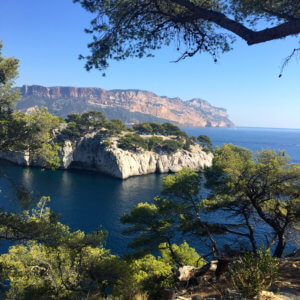 Years ago, during a summer of too much wine and too little sleep, I got wind of Cassis’s singular charms. So I detoured here, away from the thongs and throngs in Cannes and St. Tropez, for a breather. Also, like many 22 year-old college graduates taking a twirl through Europe, I had Simone de Beauvoir’s autobiography The Prime of Life adding ballast to my duffel. I was gripped by her tactile and achingly gorgeous language of the natural world she encountered during her long hikes near Marseille, where she was a young teacher, especially her treks on the “copper-colored cliffs” from Cassis to La Ciotat.
Years ago, during a summer of too much wine and too little sleep, I got wind of Cassis’s singular charms. So I detoured here, away from the thongs and throngs in Cannes and St. Tropez, for a breather. Also, like many 22 year-old college graduates taking a twirl through Europe, I had Simone de Beauvoir’s autobiography The Prime of Life adding ballast to my duffel. I was gripped by her tactile and achingly gorgeous language of the natural world she encountered during her long hikes near Marseille, where she was a young teacher, especially her treks on the “copper-colored cliffs” from Cassis to La Ciotat.
I bunked at a clean, two-star hotel by the port and the first morning, filled my bag with just-picked cherries and several slices of Corsican saucisson from the provençal market on Place Baragnon. Then, I set out to hike the calanques, the rugged, blinding white rock formations between Cassis and Marseille that descend to form narrow inlets of swimmable neon-blue sea. I returned–exhausted but elated–in time to stretch my bones on the Plage Bestouan, right in town. Already Cassis had performed some kind of primordial magic on me. It was like a blast of oxygen.
Recently, I’d grown nostalgic for my epic head-clearing in Cassis all those years ago. So after a trip to Italy, I left my husband at the Milan airport and returned to this bling-free oasis on the Riviera.
For sheer geological bravado, Cassis has few, if any, peers in France. I’d forgotten about the grandeur of Cap Canaille, the highest maritime cliff in Europe, or what happened to my heart when I first caught sight of it. Like the Grand Canyon, its palette changes all day as the sun moves across the sky – from charcoal to violet, ochre to hot pink. It is noble and grand, and the vision of it so mesmerizing that I scurried around Les Roches Blanches, the only four-star hotel in town, taking pictures – from the deck, the dining terrace and my own room.
I descended into the town center for my second strong coffee. It’s a short walk from the hotel, past a building that houses a foundation that was once the Panorama Hotel, where in the 1920’s, Winston Churchill took art lessons and began his parallel career as a painter. At the bottom of the hill, the half moon beach curves around a cove lapping Caribbean green water, and ends in a comically picturesque lighthouse. I remembered the place from when I was younger and much more tan, and soon I was on Quai Barthélemy, a promenade that frames the small harbor with cafés and pastel colored buildings. There are fishing boats and bite-sized yachts and not a rhinestone bikini in sight. Some of my best memories have been in St. Tropez, but I no longer go near the port – too much noise and blatant self-absorption. True, it’s morning in Cassis, but it’s easy to sense why some people compare this gentle place St. Tropez fifty years ago.
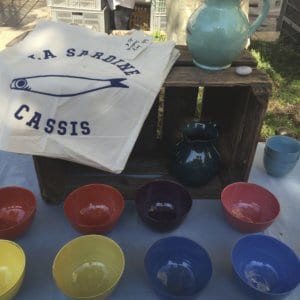 It is market day and it too has an easy grace. I stock up on late summer figs and pop so many sweet Muscat grapes, I hasten to buy another bunch. I eat a bagful of sugar cookies flavored with oranges, lemons and almonds. Stores, too, are of the rare homespun variety – none of the big chains proliferating four-to-a-block in the rest of France. No Starbucks or Mac-Do, either. I walk to the lovely Eau de Cassis flagship store, chic and welcoming. The house was founded in 1851, and all of its scents carry notes from France’s heady south: mimosa, rose, violet, lavender, citrus, rosemary. Not that it matters, but their names, too are swoonworthy – Soleil de Cassis, La Mer, Elixir des Calanques – and I’d like to stock up on all of them as a sensory antidote to the dreaded New England winter.
It is market day and it too has an easy grace. I stock up on late summer figs and pop so many sweet Muscat grapes, I hasten to buy another bunch. I eat a bagful of sugar cookies flavored with oranges, lemons and almonds. Stores, too, are of the rare homespun variety – none of the big chains proliferating four-to-a-block in the rest of France. No Starbucks or Mac-Do, either. I walk to the lovely Eau de Cassis flagship store, chic and welcoming. The house was founded in 1851, and all of its scents carry notes from France’s heady south: mimosa, rose, violet, lavender, citrus, rosemary. Not that it matters, but their names, too are swoonworthy – Soleil de Cassis, La Mer, Elixir des Calanques – and I’d like to stock up on all of them as a sensory antidote to the dreaded New England winter.
When traveling alone, I like to do it up at lunchtime. Dinners can sometimes give too strong a dose of solitude. So, I head to the port and settle myself at Nino, where I appeal to the waiter’s compassionate nature and beg for a single portion ofboulliabaisse – normally it’s prepared only for two. France’s Bandol rosés come from barely 20 miles away, but Cassis has its own celebrate vineyards, and I order a glass of Clos d’Albizzi, a crisp, fresh white.
In the afternoon, I book a boat ride through the calanques. The chalky white cliffs jut skyward from the water, and we peer as if from the bottom of the canyon to see fingers of light blue water edged by sandy beach. Arthur Rimbaud wrote about these “secret rivers of Cassis,” and it’seasy to see why poets would be inspired by these ghostly stone grottoes.
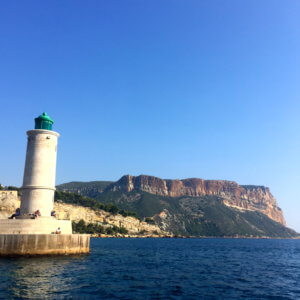 My days alternate between exertion and languor. I make the long trek to the edge of Cap Canaille to La Ciotat. Back in the day, Ms. De Beauvoir hit the trail in a sundress and espadrilles, stocked with a banana and a bun. I’m in hiking shoes and my moisture-wicking best, armed with water, power bars and Anthelios SPF 60. It’s a long day of walking, punctuated with gorgeous views of the calanques, the Bay of Cassis and off to Marseille.
My days alternate between exertion and languor. I make the long trek to the edge of Cap Canaille to La Ciotat. Back in the day, Ms. De Beauvoir hit the trail in a sundress and espadrilles, stocked with a banana and a bun. I’m in hiking shoes and my moisture-wicking best, armed with water, power bars and Anthelios SPF 60. It’s a long day of walking, punctuated with gorgeous views of the calanques, the Bay of Cassis and off to Marseille.
My last day in Cassis, I meet a friend who has family in Marseille and we set out on a rocky and somewhat treacherous trail to the nearest calanque, Port Miou. I had hiked to some of the more remote ones when I was here decades ago, but this time, the sun seemed sharper and more baking, even in my hat. We see tufts of yellow gorse, gnarled clusters of rosemary, and Aleppo pines, whose scent is beautifully overpowering. We make our way to the bottom, strip to our bathing suits, and dive into the water.
Back at the hotel, I decide that this is the loveliest town on the Mediterranean. It’s not glamour I seek in Cassis, but its opposite: the anti-decadence. Just as the first time I visited, the senseof contentment was almost tactile as I descended cliffs, floated in the sea, moved my feet across the quai. What’s more, there is flowing rosé and plenty of sun under which to drink it.
Marcia DeSanctis is the New York Times bestselling author of 100 PLACES IN FRANCE EVERY WOMAN SHOULD GO (Travelers’ Tales/Solas House, 2014). She is a regular contributor to Vogue and Town & Country, and has also written for Marie Claire, The New York Times, Creative Nonfiction, LitHub, O the Oprah Magazine, Architectural Digest, The Sunday Telegraph, Tin House and many other publications. She is the recipient of five Lowell Thomas Awards for excellence in travel journalism for her essays from Rwanda, Haiti, Morocco, France and Russia.

